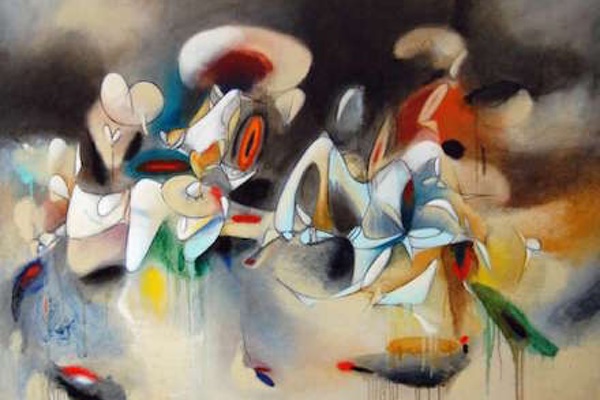The Creation of “Hope in a Hopeless Place”
By Daniel Ketelhut
See his work in Vol. IV #9
Like most artists, my process has changed over the years and continues to evolve. With the help of a few photos, I’m going to talk about the way I currently create my paintings. That said, the process detailed below is not always how I paint, but it does characterize generally how most pieces come about.
The piece whose development I’m going to detail is titled “Hope in a Hopeless Place” and can be seen in my upcoming show at Pulse Gallery called “Oil + Glass”, which opens on July 5th. The show will feature my oil paintings and the glasswork of Rob Morey – everyone reading this is invited (for details see my news section).
Okay, on to my process! Like almost every painting I do, this one started out as a sketch. I start my sketches by randomly scribbling on the page. I then stare at this mass of scribbles until I see interesting shapes and forms (much like we all do with clouds). The sketch develops as I darken the lines, which bring out these shapes and forms. By the way, this process of creating images through random scribbles is known as automatism and was first brought to prominence by the surrealists.

The next phase of the process involves doing two drawings, one grayscale, the other color. The grayscale drawing is done using both powdered and stick graphite as well as my much loved Pink Pearl erasers. Doing this drawing is typically my favorite step of the pre-painting part of the process. Using the eraser to bring out the images on the graphite-smeared surface seems like an almost magical act, with forms and shapes emerging from some other realm. It is also at this stage that the value range is more or less established.

The second drawing in the series is the color one and is done in pastel. The outlines of the primary shapes and forms are done with stick graphite. It is at this stage that most of the color choices are made. Pastels are a great medium for establishing color – they are easy and fun to work with and they can be erased and/or gone over with other colors. At this stage, the value range is sometimes further enhanced.

Okay, now on to the painting. With the value range and color choices generally established, executing the painting is largely a process of doing what I did with the pastel drawing, only instead of using pastel on paper, I’m using paint on canvas or panel (canvas in the case of “Hope in a Hopeless Place”). That said, doing the painting is rarely a process of simply copying the drawing in paint. Paint, and oil paint in particular (not that I’m biased toward the medium at all), is a wonderful, seductive, luscious medium which, in the process of working with it, can sometimes dictate what it wants to do rather than me dictating what I want it to do. In the case of “Hope in a Hopeless Place,” I built the painting up using several transparent glazed layers, and then incorporated more opaque applications (called scumbles in artspeak). I also allowed the paint to drip and run in several locations. The actual painting process is one of give and take as I work back and forth between figure and ground, between glazing and scumbling, and between dark and light – until the right balance is achieved. Arriving at this balance is the most magical, intuitive part of the whole process – you simply know you’re there when you arrive.

Originally published on Daniel Ketelhut’s website.

